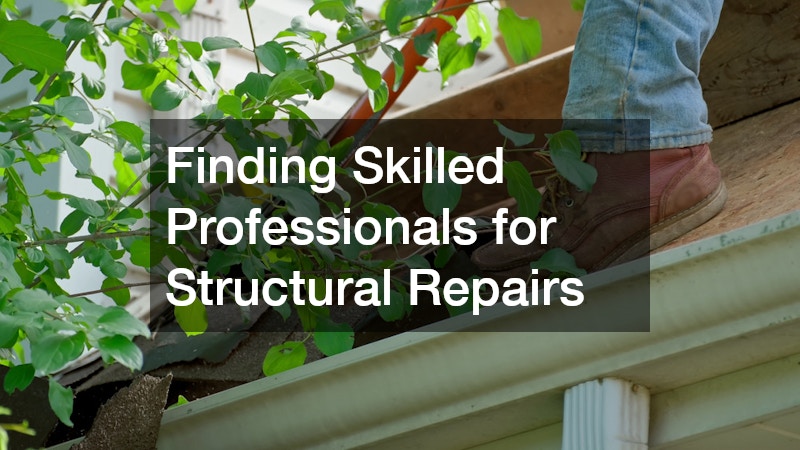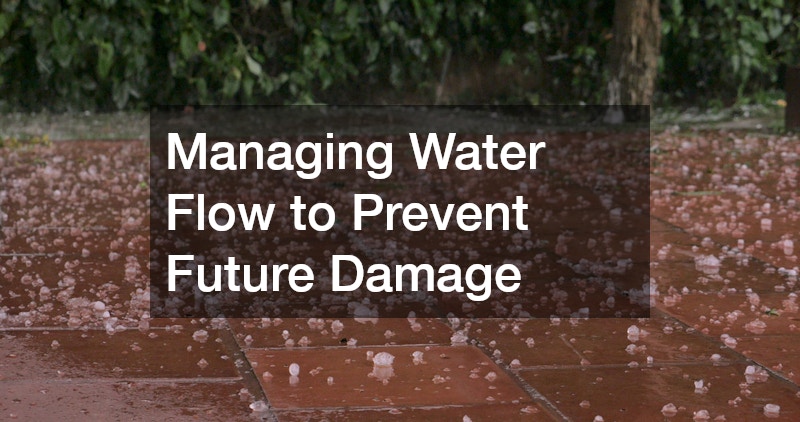Severe weather events can cause significant damage to homes and properties, leaving homeowners facing an overwhelming task of recovery and repair. Whether it’s high winds, heavy rain, hail, or tornadoes, the aftermath of a storm can affect many aspects of your property—from the roof overhead to the trees and landscaping around your home. The process of recovering from storm damage involves more than just fixing what’s broken; it requires a careful assessment of the damage, prioritizing repairs, and taking preventive measures to safeguard your home from future storms.
Navigating this recovery process can be stressful and confusing, especially when you are dealing with multiple areas of your property that may have been affected. Understanding the necessary steps and the types of professionals you need to involve can make a world of difference in how smoothly your restoration progresses. From assessing your trees to inspecting your roof, from removing hazardous debris to repairing or replacing damaged structures, each part plays a crucial role in restoring safety and comfort to your home.
Moreover, storm damage recovery is not only about immediate fixes. It’s also about investing in long-term solutions that will better protect your home in the future. Proper maintenance, durable materials, and thoughtful landscaping can help reduce the impact of future storms. Taking the time to work with trusted experts and understanding the options available to you ensures that your home remains resilient.
Assessing the Impact on Your Trees and Landscape

Storms often leave a lasting impression on your yard and trees, which play a vital role in your property’s overall health and value. After a storm, the first step in recovery is carefully evaluating the condition of your trees and landscape. This assessment helps identify damaged limbs, weakened trees, and other hazards that could threaten your home’s safety.
Local arborists are trained professionals who specialize in tree health and maintenance. They have the knowledge to determine which trees can be saved and which ones pose a risk due to storm damage. Arborists will inspect trees for broken branches, cracked trunks, root damage, and signs of disease or decay caused or worsened by the storm. Their expertise ensures that trees are handled properly, preserving those that are salvageable and safely addressing those that aren’t.
By involving arborists early in the recovery process, you can prevent potential hazards such as falling branches or unstable trees that might cause further damage during future storms. Proper care and treatment of your trees also support the overall beauty and functionality of your landscape, maintaining shade, privacy, and curb appeal.
In addition to safety concerns, damaged trees can have financial implications, affecting property value and insurance claims. Local arborists can provide detailed reports that may assist in documenting damage for insurance purposes. Furthermore, professional pruning and trimming help improve tree health, encouraging regrowth and reducing the chance of future storm damage.
Safely Removing Damaged or Hazardous Trees
Sometimes, the damage to your trees is too severe to warrant saving them. In these cases, safe removal is critical to protecting your property and family. Tree removal companies specialize in handling hazardous trees that have been weakened or uprooted by storms.
Removing storm-damaged trees requires skill and the right equipment to avoid accidents and further property damage. Professionals evaluate the best methods for removal based on the tree’s size, location, and condition. This often includes safely cutting branches, stabilizing the tree if needed, and carefully lowering it to the ground to prevent harm to your home, vehicles, or power lines.
Tree removal companies also handle stump grinding and cleanup, leaving your yard clear and ready for restoration or landscaping. Choosing experienced professionals ensures that the removal process is efficient, safe, and minimally disruptive to your property.
Safe tree removal after a storm is especially important to prevent accidents during cleanup efforts. Homeowners attempting to remove large or unstable trees themselves risk injury and additional property damage. Tree removal companies use specialized tools and adhere to safety protocols to manage these risks effectively.
Moreover, professional removal companies often offer emergency services, responding quickly after storms to clear dangerous trees that could block access or interfere with utilities. Their timely intervention helps stabilize your property and accelerates the overall recovery process.
Conducting a Thorough Post-Storm Property Evaluation
Beyond your yard and trees, a comprehensive inspection of your entire property is essential following a storm. Storm damage inspection professionals provide detailed assessments to identify all affected areas, including hidden damage that might not be immediately obvious.
A thorough inspection covers the roof, gutters, siding, windows, foundation, and drainage systems. Inspectors look for missing or damaged shingles, leaks, cracks, water intrusion, and structural weaknesses. Early detection of these problems allows you to address them before they escalate into more costly repairs.
Storm damage inspections often include detailed reports with photos and recommendations, which can be invaluable when working with insurance companies. Hiring certified inspectors helps ensure that nothing is overlooked, giving you a clear picture of the repairs needed to restore your home’s safety and integrity.
In some cases, damage may be subtle but severe, such as weakened roof decking or compromised flashing that can lead to leaks over time. Storm damage inspection specialists are trained to spot these issues and recommend appropriate repairs or replacements.
Additionally, a comprehensive property evaluation includes checking yard drainage systems, trees, fences, decks, and other outdoor structures that may have been affected by flooding or high winds. This holistic approach helps you create a detailed recovery plan covering all aspects of your home.
Finding Skilled Professionals for Structural Repairs

Once the damage is identified, finding skilled professionals to carry out necessary structural repairs is the next priority. Roofing contractors are experts in repairing or replacing damaged roofing components and ensuring your home is protected from the elements.
Professional roofing contractors assess the extent of damage and provide solutions ranging from minor repairs to full roof replacements. They are knowledgeable about local building codes and use quality materials to guarantee durability and compliance with safety standards.
Engaging reputable contractors also means your repairs will be backed by warranties and performed with the latest techniques, providing peace of mind that your home will withstand future storms more effectively.
Beyond roofing, some contractors offer comprehensive structural repair services addressing issues like damaged framing, siding, or gutters. This can streamline the restoration process by coordinating all necessary repairs with one trusted provider.
Choosing the Right Experts for Your Roof Restoration
Restoring your roof after storm damage requires choosing the right roofing company to manage the project efficiently and professionally. A trusted roofing company not only repairs damage but also works with you to navigate insurance claims, timelines, and budgeting.
Good roofing companies prioritize communication and transparency, ensuring you understand the scope of work and costs involved. They also handle permits and inspections required by local authorities, streamlining the restoration process.
Selecting a roofing company with proven experience in storm damage recovery ensures your roof is restored to its original condition—or better—enhancing your home’s protection and value.
Additionally, experienced roofing companies often have relationships with suppliers, allowing them to secure quality materials quickly, which can be critical in post-storm situations when demand is high.
When to Consider Full Roof Replacement
Not all storm damage can be repaired with simple fixes. In some cases, the damage to your roof is extensive enough to warrant a full roof replacement. Signs that a replacement is necessary include widespread shingle loss, structural damage, leaks that cannot be fully repaired, and roofing materials past their useful life.
A full roof replacement provides a fresh start and an opportunity to upgrade to more durable materials or better insulation. It also eliminates recurring repair costs that might occur with an aging, storm-damaged roof.
Roof replacement specialists guide homeowners through the selection of materials, colors, and styles, ensuring the new roof meets both aesthetic and functional needs. Making the decision to replace your roof can significantly enhance your home’s resilience against future storms.
While roof replacement is a significant investment, many insurance policies cover storm-related damage, making this option more accessible. Discussing your options with your roofing company and insurance adjuster can help determine the best path forward.
Addressing Common Roof Issues Promptly

Storm damage often results in common roofing problems such as missing shingles, leaks, damaged flashing, and clogged gutters. Addressing these issues promptly is critical to preventing further damage to your home’s interior and structure.
Roof repair services focus on these smaller but urgent problems, restoring the roof’s protective barrier and stopping water infiltration. Timely repairs can extend the life of your roof and avoid costly consequences such as mold growth, wood rot, and interior water damage.
Regular maintenance combined with immediate attention to storm-related issues keeps your roof in optimal condition and protects your investment.
Waiting too long to fix minor roof problems after a storm can lead to increased damage during subsequent weather events. Quick action from a reputable roof repair service helps safeguard your home and peace of mind.
Working With Trusted Local Roofing Specialists
Choosing to work with a local roofing company offers advantages such as quick response times, knowledge of regional weather patterns, and familiarity with local building codes. Local specialists can provide personalized service and build a reputation for reliability within the community.
These companies often have established relationships with suppliers, allowing them to source quality materials promptly. They are also better positioned to handle emergency repairs after storms and provide ongoing maintenance tailored to your area’s specific needs.
Supporting local roofing companies ensures you receive dedicated service and contributes to the local economy.
Additionally, local roofing companies tend to have extensive experience dealing with the types of storm damage common to your region, which can improve the quality and durability of repairs.
Exploring Durable Roofing Options for Added Protection
When restoring or replacing your roof, considering durable options such as metal roofing can provide long-term benefits. Metal roofs are highly resistant to wind, hail, fire, and heavy rain—common causes of storm damage.
Besides durability, metal roofing offers energy efficiency through reflective coatings that reduce heat absorption, helping lower cooling costs. Metal roofs also require less maintenance and have longer lifespans compared to traditional asphalt shingles.
Exploring these options with your roofing specialist can lead to a stronger, more resilient home that stands up better against severe weather events.
Metal roofing also offers a modern aesthetic that can increase curb appeal and home value. While the initial cost may be higher, many homeowners find the long-term savings and protection worth the investment.
Managing Water Flow to Prevent Future Damage

Proper yard drainage plays a critical role in minimizing storm damage risks. When water pools near your home’s foundation or fails to drain away effectively, it can cause soil erosion, basement flooding, and structural damage.
Managing water flow involves grading your yard to direct runoff away from your home, installing drainage systems such as French drains or swales, and maintaining gutters and downspouts to handle heavy rainfall.
Taking these preventative steps not only protects your home during storms but also preserves landscaping and reduces long-term maintenance costs.
Improving yard drainage can also help prevent mold and mildew growth in basements and crawl spaces, contributing to healthier indoor air quality.
Regular inspection and cleaning of your drainage systems, especially after storms, keeps them functioning optimally and reduces the risk of water-related damage.
Recovering from storm damage is a multi-step process that requires attention to various aspects of your property. From evaluating the condition of your trees and safely removing hazardous ones to conducting thorough inspections and repairing or replacing damaged roofing, each step plays a vital role in restoring your home’s safety and functionality. Engaging local experts—from arborists to roofing specialists—ensures that repairs are done properly, efficiently, and in compliance with safety standards.
Taking prompt action after a storm prevents minor issues from developing into major problems, saving you time and money in the long run. Moreover, investing in durable materials and effective drainage systems strengthens your home’s resilience against future weather events. These preventative measures reduce the likelihood of extensive damage and provide peace of mind.
Storm damage recovery is not just about fixing what was broken; it’s an opportunity to improve and protect your home for years to come. By following these essential steps and working with qualified experts, you can ensure your property remains safe, comfortable, and ready to face whatever challenges come next. Staying proactive and informed empowers you to safeguard your investment and maintain the beauty and security of your home for the future.



